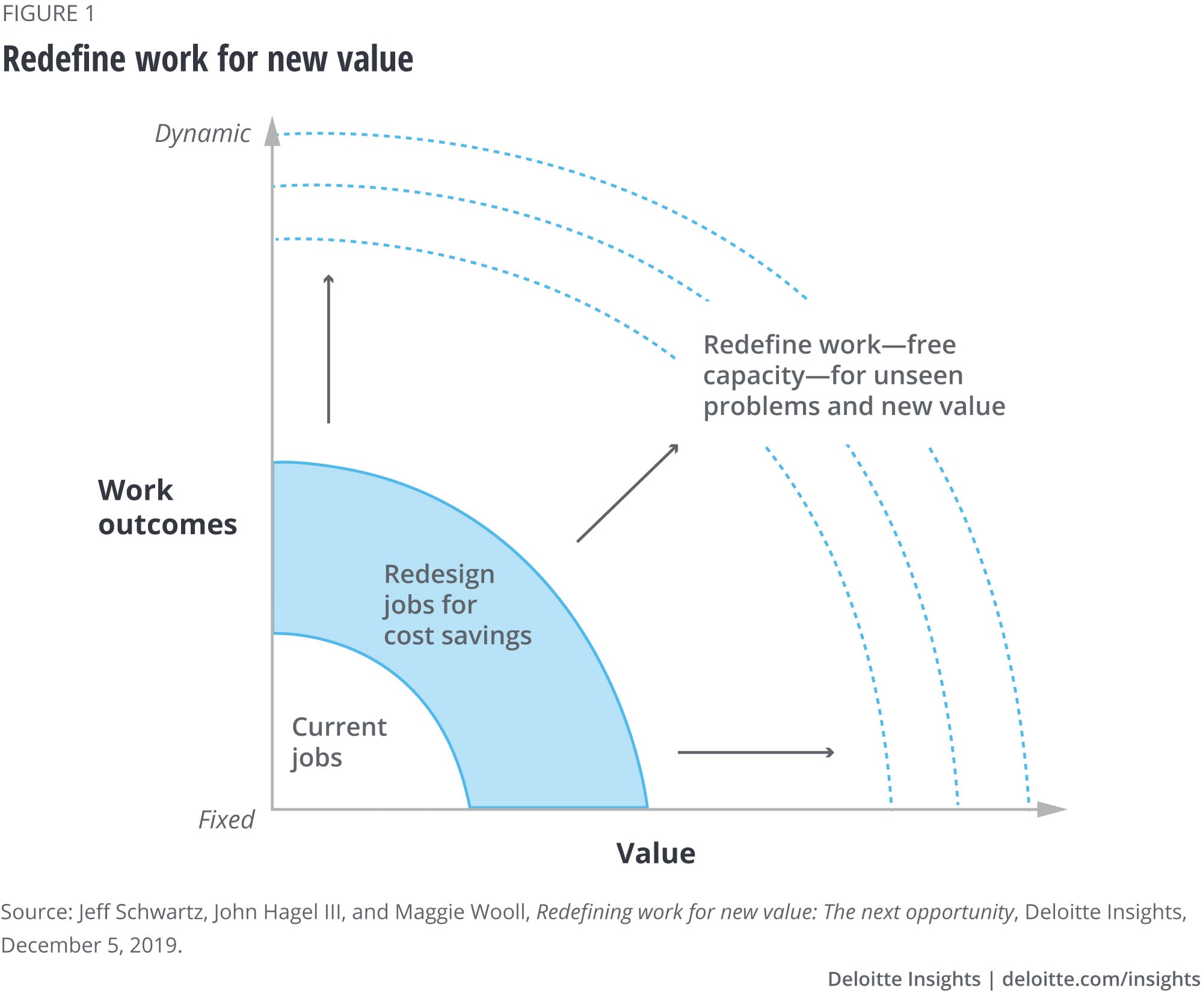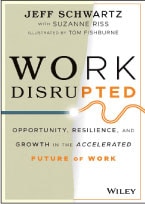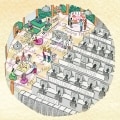
Create opportunity for and with the workforce Reimagining work and partnering with workers
10 minute read
25 January 2021
Driven by disruption and enabled by technology, leaders today have the chance to fundamentally reimagine ways of working to engage their people in new, mutually rewarding ways.
“Everyone is talking about the future of work. But few are asking the most fundamental question: What should that work be?”— John Hagel, management consultant and author1
If you have ever experienced whitewater rapids, you know the exhilarating sensation of making hairpin turns to avoid rocks; changing direction every few seconds; and trusting your team, your very wet, adrenaline-pumped team, as you cut through rushing currents. Few have navigated the treacherous Covid-19 rapids as deftly as Eric Yuan, CEO of Zoom, the now ubiquitous videoconferencing technology company. Zoom was founded in 2011 when the videoconferencing market was already in full swing. That same year, Microsoft bought Skype for US$8.5 billion.2 Four years earlier, Cisco, the internet networking giant, bought WebEx, another leading videoconferencing company, for US$3.2 billion.3 Yet when the world went into quarantine, and businesses and schools relocated to living rooms, everyone learned to Zoom.
Learn more
Explore the Future of Work collection
Learn about Deloitte’s services
Go straight to smart. Get the Deloitte Insights app
Though Yuan and his team had trained on responding to natural disasters in the run-up to going public in 2019, they never imagined they would face the size of the surge in demand. But they were prepared: Zoom’s data centers were set up to handle traffic surges of 10 to 100 times normal, Yuan says. Zoom did not miss a beat when, overnight, everybody realized they needed a tool like Zoom to connect their people. In a typical day early in the pandemic, 343,000 people globally downloaded the Zoom app, compared with 90,000 people worldwide just two months earlier, according to mobile intelligence firm Apptopia. That’s almost four times as many downloads in a single day. With engineering teams across the globe, Zoom was able to remotely monitor its systems around the clock.4
The job of business leaders today can resemble navigating in unpredictable, turbulent, crowded, and even dangerous waters. Whitewater is named for the bubbly, unstable, aerated, frothy water that appears white. As John Seely Brown (JSB), former cochair of Deloitte’s Center for the Edge, has reminded us, “we are living in a whitewater world. It’s a world that is rapidly moving in often surprising and unforeseen ways.” Like a whitewater kayaker, business leaders must learn to skillfully read the currents and disturbances of the context around them, “interpreting the surface flows, ripples, and rapids for what they reveal about what lies beneath the surface.”5
Navigating the rapids also involves the occasional crash into rocks or capsizing. Yuan, the entrepreneur, experienced such challenges early in the quarantine, including security and privacy breaches. He responded by acknowledging the problems and working harder to address them. He also learned more about his customer base, always a prime focus for Yuan. The typical Zoom client had been a company’s chief information officer who had been introduced to the product’s functionality, including privacy features, and leveraged them. With the pandemic came many first-time users who thought nothing of posting on social media a gallery view from a Zoom call, which they did not realize included their meeting room and password. Suddenly, complaints of “Zoom bombing” arose, with strangers crashing videoconferencing calls. Yuan and his team quickly realized that Covid-19 crisis brought a different user base to his product, one that did not know about Zoom’s security features. As a result, Zoom shifted to focus on “how to make it easier for first-time users,” Yuan explains. “We changed our practice.”6
Companies poised to thrive in today’s whitewater world, and the future world of work, are organized to facilitate quickly creating new products, services, and experiences. They are sensing and building, responding and growing, as they focus on continual improvement. They work in highly integrated teams, with a dedicated customer focus, and the ability to deliver in sprints. Agile by design, the next minimum viable product (MVP) is their touchstone.
The rapid rise of Zoom during the first half of 2020 is likely to be a case taught in business schools. And well it should. While Zoom will attract its fans and critics, it is hard to argue that there is not something essential to learn from this evolving story. In uncertain and volatile markets, nimble, entrepreneurial companies can take on corporate giants and reorder industries. This is the growth opportunity of leading in the whitewater world through maintaining an almost fanatical focus on usability and customer experience (“it’s so easy to use”), building for scalability, investing in resilience, and managing a team focused on continual improvement and unseen problems. The Zoom team’s ability to navigate the whitewater environment illustrates the types of challenges in which humans excel, and AI, so far, does not.
Key mindset shifts for business leaders
Create value, meaning, and impact, moving beyond cost reduction and efficiency as the main goal
“Everyone is talking about the future of work. But few are asking the most fundamental question: What should that work be?” John Hagel and John Seeley Brown (JSB), former cochairmen of Deloitte’s Center for the Edge since 2007, have been asking questions like this in their work to identify emerging opportunities and big shifts in the business landscape.7 In their recent research, they dive deeply into this question: The future of work to what end? Their research points out that “far too many initiatives are focused on incremental gains or efficiency-boosting activities.” They call robotic process automation, AI, and machine learning “shiny new tools” that companies can implement to cut costs and work faster with less human labor. However, they caution that “when organizations subscribe to this narrow perspective, the work of tomorrow will be the same as the work of today.” As Hagel and JSB point out, the opportunity is greater than doing more of the same, only faster and cheaper. The big opportunity is to expand notions of value beyond the cost to the company. Companies have additional levers to explore new sources of value and meaning to remain competitive amid rapidly changing market dynamics.8 Companies that successfully redefine work to focus on our human qualities enable their employees to engage in four types of activities: identifying unseen problems and opportunities; developing approaches to solve problems and address opportunities; implementing new approaches; and iterating and learning based on the impact achieved. The Zoom example powerfully illustrates human beings excelling in each of these four types of activities.
Actions:
- Shift the objective of work beyond efficiency to expand the value and impact delivered to customers, workers, and communities.
- Fundamentally redefine work from executing routine tasks to creatively addressing unseen problems and opportunities.
- Cultivate work to use our human qualities, shifting from skills to capabilities.
- Build relationships within and across teams so that managers and workers can focus on output and impact, not just on workflow and transactional activities. Connect teams so they consider the impact and think about what’s important to customers and workers.
- Instill a culture of tolerance for heterodox ideas and risk-taking.
Focus on redefining work as the way forward, not just redesigning jobs
The application of robots, robotic process automation, and cognitive and AI technologies offers unprecedented opportunities to improve efficiency and productivity. Unfortunately, many companies are aiming their future of work efforts narrowly at job redesign for efficiency and cost savings, which will only get them so far, rather than at redefining work. In the limited view of redesigning jobs, workers represent cost savings rather than the capacity to create new value for the business and the customer. When most companies redesign jobs, their narrow focus is on productivity—the same work outputs, only faster and cheaper, with fewer errors. The challenge is not only to redesign jobs but to expand the focus to redefining work, including product strategies and business models.

By redefining work, employees at all levels focus on finding and addressing unseen problems and opportunities. “The unseen is a key aspect of redefining work,” Hagel and JSB have noted in their research. “Addressing a hidden problem or opportunity has the potential to create more value because it has been neither considered nor understood; there is room for far more learning, and impact, by trying to better understand a brand-new situation than from making incremental improvements on a well-defined issue.”9
A critical shift for business leaders is to balance the focus on efficiency and productivity on the one hand with innovation and value on the other. Innovation does not arise from productivity and efficiency unless work teams, managers, and employees are challenged to recognize that better work is not just more of the same. It is something new: new value, products, new services, new experiences—also known as entrepreneurialism. It is a fusion of value for the customer and well-being for the workforce.
Cost savings and efficiency can have larger and longer lasting value when business leaders use the cost savings to fund investments in new products and to strengthen customer relationships and experiences. As we have noted, the proliferation of ATMs resulted in redesigning the jobs of retail bankers so that they offered a different service from the machines. Retail bankers were no longer simply dispensing cash but they could spend more time with customers, introduce them to new products and services, and extend the bank’s ability to offer a higher level of customer interaction and service. Doing more of the same, and doing it faster, is not where the magic happens—the magic is when workers and teams can solve new problems and create new value, services, and relationships.
Actions:
- Integrate job redesign—for speed and improved output through automation—with work redefinition to create new value with freed capacity.
- Challenge work groups and teams to focus on uncovering unseen problems—not just cost savings.
- Create work group agency so teams have the focus and the flexibility to both produce the product and improve the product. As we have learned from the Toyota factory line, among the world’s most productive and innovative manufacturers, the job of the work group on the line is not just to execute production but to improve production and quality.10
- Build work groups and teams around the relationships that will drive innovation, contribution, and well-being, not just efficiency. Design and connect work groups and teams in networks, within and beyond the enterprise, to create value and opportunity for workers and customers.11
Doing more of the same, and doing it faster, is not where the magic happens—the magic is when workers and teams can solve new problems and create new value, services, and relationships.
Leverage the entire open talent continuum, from full-time workers to freelancers, crowds, along with virtual and digital workplace options
Work and workforces have been increasingly separated from companies as we have witnessed with the expansion of the alternative workforce—managed services, contractors, freelancers, gig workers, and crowds. As the workforce has expanded to a much broader continuum of employment models who are working in new ways, and in new places, the traditional talent management mindset of “attract, develop, retain” employees is giving way to new approaches. Historically, the employee life cycle has focused on recruiting the employees we need; developing them with prescribed, linear, career paths; and holding on to them—especially the “critical talent”—as long as possible.
Deloitte Consulting LLP’s Workforce Transformation practice is developing a new approach, beyond the traditional employee life cycle, to a workforce ecosystem cycle, shifting to a new mindset: access, curate, engage. 12
Access: How do you tap into capabilities and skills across your enterprise and your broader ecosystem? This includes sourcing from internal and external talent marketplaces and leveraging and mobilizing on- and off–balance-sheet talent.
Curate: How do you provide employees—ecosystem talent—and teams with the broadest and most meaningful range of development? This includes work experiences that are integrated into the flow of their work, their careers, and their personal lives.
Engage: How do you interact with and support your workforces, business teams, and partners to build compelling relationships? This includes multidirectional careers, in, across, and outside of the enterprise; and for business leaders and teams, providing insights to improve productivity and impact while taking advantage of new ways of working and teaming and new digital technologies.13
Actions:
- Integrate talent and workforce strategies and programs to access, curate, and engage capabilities from within and across the enterprise and ecosystem.
- Explore how to use talent and opportunity marketplaces, not just HR managers and administrators, to deploy people by giving them agency to choose full-time and part-time jobs, gigs, and assignments across your organization. Watch workforce engagement rise and the quality of workforce information and analytics improve.
- Develop an organizational culture, as well as manager and team incentives, to encourage development and stretch assignments. Reinforce the concept that employees work for the company, not just one division or one manager.
- Build relationships across the entire talent ecosystem for your industry to be able to broadly access talent and create opportunities for people to move in and out of your organization for jobs and projects.
- Create an environment providing the comfort, connection, and opportunity to contribute that workers are seeking, where they feel they are part of the organization’s mission, purpose, and team.14
- Recognize that work and teams are increasingly structured around projects. A number of creative industries, including films and media, have moved from vertically integrated studios and companies to a portfolio of projects—where each project can be crafted and constructed to access capabilities and talent, from almost anywhere to create unique results.
- Understand that the relationship between work and workplaces are in the midst of fundamental shifts. These changes have been accelerated globally by the Covid-19 pandemic. During the public health crisis, a record number of workers shifted almost overnight to remote and virtual work. MIT research reported that in the first week of April 2020, just under 50% of workers surveyed in the United States were working remotely.15 A survey of CFOs during that same time period reported that 74% of organizations surveyed expected to move at least 5% of their workers to permanently remote positions post Covid-19, and a quarter of organizations surveyed were planning to move at least 20% of workers to permanent remote work.16 Redesigning work for remote and hybrid ways of working is a key action and opportunity for business leaders.
In a world of paradoxes, speed, complexity, and machines, we need to lead by doing uniquely human things. People imagine the future; people compose music, work, businesses; and people activate curiosity, passion, connectedness, and belonging. We sometimes need to be reminded that we invented all of this technology.
Business leaders can set goals that reach beyond cost and efficiency to include value and meaning. They have the chance to analyze, redesign, and redefine work, workforce, and workplace options that take advantage of the value of automation, alternative talent sources, and collaborative workplaces. And they can align the organization, leadership, and workforce development programs to access skills, curate next-generation experiences, and engage the workforce of the future in long-term relationships and business leaders in new ways of working.

To learn more, including the complete list of key mindset shifts, explore
the author’s book Work Disrupted.
Adapted with permission of publisher, Wiley, from Work Disrupted: Opportunity, Resilience, and Growth in the Accelerated Future of Work by Jeff Schwartz, copyright © Wiley. All rights reserved. This book is available through all bookstores and online booksellers.
Explore the future of work
-
Can we realize untapped opportunity by redefining work? Article6 years ago
-
A pragmatic pathway for redefining work Article5 years ago
-
Returning to work in the future of work Article4 years ago
-
If we rebuild, will they come back? Article4 years ago
-
The future of cloud-enabled work infrastructure Article4 years ago
-
Bridge across uncertainty Article4 years ago









